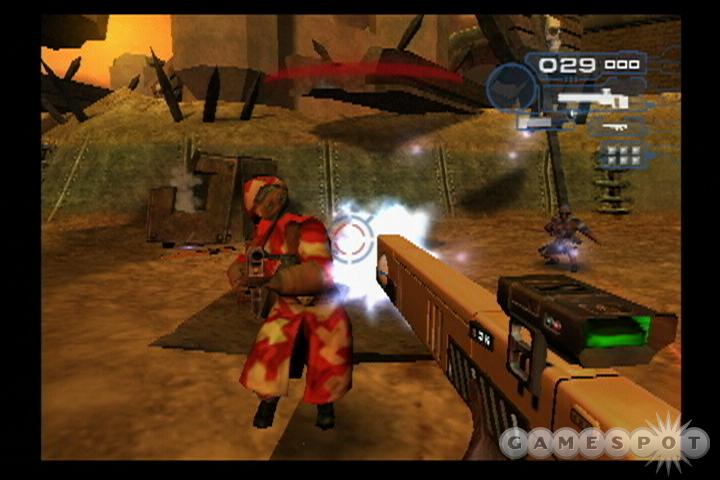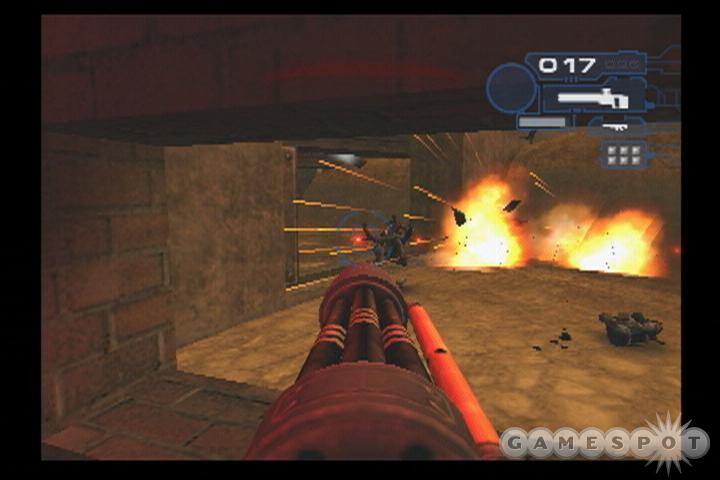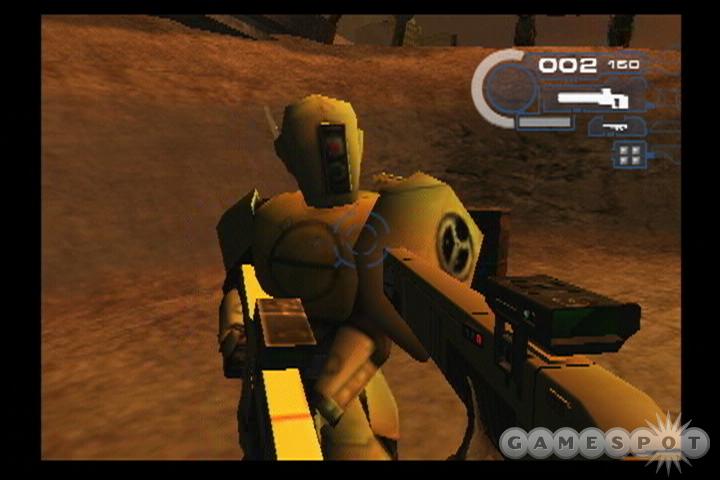Warhammer 40,000 has long deserved a shooter. A veritable cult has grown up around Games Workshop's combat miniatures franchise over the past two decades. Popularity aside, the gritty 41st century universe "where there is only war" is a perfect fit for first-person action. It would be hard to mess up a game that features forces like the Imperium, Dark Eldar, Orks, and Necrons, who are all eternally locked in battle. Yet that's pretty much what Kuju Entertainment has done. The British developer best known for 2001's Microsoft Train Simulator has exchanged the depth and dynamism of the Games Workshop franchise for a shooter-by-numbers approach in Warhammer 40,000: Fire Warrior. Intense in spots, Fire Warrior carries little of the punch found in the tabletop game due to a positively antediluvian shoot-'em-up design and lots of key hunts.

The design never gets beyond ideas that have been kicking around since Wolfenstein 3D and Doom, despite a Halo-esque rechargeable shield, a two-weapon restriction, and a story that turns Warhammer gaming on its head. Instead of playing the usual Imperium space marine, you take the role of Kais, a Tau warrior who takes on the Imperium. This changed focus is somewhat reminiscent of Warhammer 40,000: Rites of War, a 1999 PC wargame where you led the Eldar against the Imperium. At any rate, those who are familiar with the source material will no doubt appreciate the opportunity to venture off the beaten path. More-casual fans, whose main exposure to Warhammer 40,000 comes from playing the Space Hulk tabletop game and its old PlayStation and PC adaptations, might be disappointed at not being able to step into space marine armor.
Not that this really matters much either way, as the plot in Fire Warrior is so hopelessly muddled that it's hard to tell what's going on until you reach the midway point of the game. Instead of easing you into the story, Kuju immerses you in a war with absolutely no setup at all. You get only a brief, chaotic cutscene that shows the Imperium attacking a Tau settlement, and then you're charging through World War I-style trenches that have been excerpted from All Quiet on the Western Front. You have to know a fair bit about the Warhammer universe to make heads or tails out of what's going on here, although if you can figure out that the bad guys are the ones shooting at you, you can get by.

So there isn't much to figure out. Each of the 21 fairly substantial levels (expect around 15 hours of play, which makes the game longer than the average console shooter these days) runs on tracks, with the final map being as straightforward as the obstacle course and firing range tutorials in the first map. You follow trenches, administration building hallways, ship passages, prison cell blocks, and other narrow corridors from one locked door to another. You only pause to take blue, orange, and magenta keys from corpses. (These keys actually look like those neon glowsticks that give kids wave around on the Fourth of July. Come on--colored keys? In 2003?). Every area carries with it a shut-in vibe, as if the developers were suffering from agoraphobia. Even during the few moments outside, you're surrounded by earthen walls that your soldier can usually stretch out and touch with both hands.
Battles are furious, set-piece affairs where you're ambushed by gangs of foes. The pace is a bit slower than average, since you often need to retreat to recharge your shield. Also, save checkpoints are spread far enough apart to make you extra cautious. Rush forward too eagerly and your shields will get drained in the midst of a pack of enemies, thus forcing you to replay large sections of a level. This is a major annoyance in some areas, especially during the lengthy watch towers and diversion levels, and when the game gets tough through the middle and latter stages.

Running ahead too fast isn't very tempting, since movement is bogged down by the gamepad. You feel more like you're swimming, rather than running, when you manipulate the analog sticks to move and swivel. Additionally, acquiring enemies in the crosshairs can be difficult without the auto-aim feature switched on. This makes a huge difference, as even commonly found hardware, like the Tau pulse rifle and the Imperial lasgun, are inaccurate. Unless you're an expert marksman, you can empty half a clip before killing even a single attacker. Still, there's no oomph. Most of the 18 weapons issue nothing but pops and electric bolts, and, as a result, they feel more like tasers than BFGs. Even the shotgun doesn't give you that "I am death incarnate" sensation that makes shooters so much fun. Only solid vibration effects give the weapons any presence at all.
Gummy controls and flimsy firearms aren't too much of a factor, because all foes--from the presumably dumb grunts of the Imperium guard to cream-of-the-crop space marines--practically paint bull's-eyes on their chests. They run right at you and often provide advance warning that they're coming by muttering such catchphrases as "Enemy detected."
Fire Warrior does look good. Aside from the measly dozen or so enemy soldier models and woeful death throes, where dying foes grip their heads like they're suffering from migraines, the art design perfectly visualizes the grim Warhammer future. Everything seems dark, dirty, and old, thanks to rough textures and a primitive color palette that's apparently limited to shades of both black and brown. Audio is also rudimentary. The repetitive "thump-thump-thump" of weapons soon feels like it's rattling around in your skull. As a result, you soon can't hear your own footsteps. Additionally, there isn't any in-game music. At least the cutscenes and dialogue sequences are well scripted and well acted. Tom Baker, the former Doctor Who, and Brian Blessed, from I, Claudius, do yeoman work bringing these scenes to life.
Online and split-screen multiplayer modes have just been tacked-on. It seems pretty obvious that Kuju included these options as a simple added sales pitch to hardcore Warhammer fans--and so that publisher THQ could put that Sony-approved "online" logo on the front of the retail box. Still, does anyone really need more deathmatch, team deathmatch, and capture the flag options? On eight measly maps? This tiny selection of maps definitely isn't anything to crow about. Each is small and practically featureless, and each consists of little more than courtyards and corridors. Online gameplay is almost lag-free, but even smooth games get boring fast when there isn't much to do.

In a nutshell, you feel like you've done it all before in Warhammer 40,000: Fire Warrior. Boredom is your biggest opponent when trying to finish this derivative game, no matter how many miniatures you've painted over the years while waiting for a pure action title based on the great Warhammer 40,000 franchise. There are some intense moments here that are filled with fierce shoot-outs, but the complexity of the Warhammer universe deserves more than simplistic shooting and key hunts.